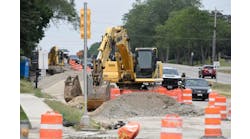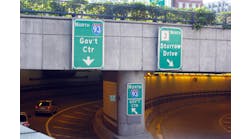Opened for traffic in 1940, the Pennsylvania Turnpike is one of the older limited-access highways in the U.S. Some of its design characteristics were patterned after the German Autobahn, which was built during the 1930s. The most common attribute of both highways is their design for driving vehicles "safely" to 100 mph.
The original length of the turnpike was 160 miles stretching between Harrisburg and Pittsburgh. This included seven tunnels that were built through different sections of the Allegheny Mountains.
Today's turnpike is 515 miles long and includes a 360-mile highway running east-west, a 110-mile northeastern extension and 45 miles of various western extensions. The east-west route connects with other limited-access highways at the New Jersey and Ohio borders; the northeast extension connects to the east-west route and proceeds north to I-81 near Scranton.
If a roadway's driving conditions are to be continually held to high standards, a comprehensive ongoing maintenance program is necessary. The Pennsylvania Turnpike Commission is well aware of this fact. As a toll road, the commission must in particular maintain high roadway standards for its paying customers, who will tolerate nothing less.
Essentially, the Pennsylvania Turnpike is operated by a private-public sector partnership and is perpetuated by receiving revenue from collected tolls. The commission receives no tax revenue from local, state or federal agencies. This past year the turnpike's income from tolls was $366 million plus $27.5 million received from plaza revenues and other sources.
As with any service-oriented enterprise, the commission must offer a value-added highway service if it is to keep its customer-paying base. There is an alternative highway for motorists. It is I-80 that runs parallel to the east-west turnpike, albeit 45 to 50 miles to the north. This highway is, of course, free to use.
Over the next 10 years, the commission projects investing $1.46 billion capital in 100 miles of the original-built roadway. Instead of continuing to overlay the original concrete pavement with asphalt, the roadway will be completely removed in favor of building a new one. Each contract let to a third party for rebuilding a section of the roadway will encompass about 10 miles of the 100-mile stretch to be reconstructed.
A touch of lime-pozzolan
A problem encountered on the first roadway section of the project was a subgrade that would call for over-excavation because of its inherent poor ground conditions. The subgrade included a large measure of clay, making it unsuitable for building a new roadway with flexible pavement. While the existing reinforced concrete (ridged) pavement was able to span most of the subgrade deficiencies, this cannot be said of the Superpave specified for the new highway.
It was evident to the turnpike engineers that a cost-effective method of stabilizing the subgrade was necessary. The predominantly clayey ground conditions run unusually deep (4 to 12 ft) along some sections of the highway's alignment.
KCI Technologies Inc., Corporate Hunt Valley, Md., the project manager and construction inspection company for the commission, presented an acceptable solution to the problem. James Lockhart, P.E. and project manager for KCI, proposed the incorporation of a lime-pozzolan mix within a predetermined design thickness in the top layer of the soil. This, he reasoned, would stabilize and strengthen the subgrade to an acceptable degree.
It is nothing new; stabilizing the top layer of unsuitable soil in the subgrade with lime-pozzolan mixes has been successfully done on other roadbuilding projects. It is new here, though--the commission has never tried this method before.
As mentioned, a reinforced portland cement concrete (ridged) pavement did not require the likes of soil stabilization. Because of its rigidity and strength characteristics, a reinforced concrete slab can span the physical-strength irregularities found in these clayey soils. However, since Superpave is the pavement selected, a much improved soil condition is required in the subgrade. By stabilizing the top layer of the subgrade, gross over-cuts made to reach acceptable ground have been eliminated. Overcutting also would necessitate importing large quantities of stone needed to backfill the excavation.
Pozzolan has been used for construction purposes since the Roman Empire where slag (pozzolan) from volcanoes was ground up. Today, pozzolan comes from either natural sources (volcano slag) or is made by usually combining fly ash with water-quenched boiler slag. Pozzolan is a popular admixture for concrete mixes, and combined with lime and water it becomes a good soil stabilizer. Whether the three ingredients are mixed solitary or mixed directly into a soil, the same chemical action takes place thus giving the compound cementitious properties. One of these properties is the gaining of superior soil strengths.
9% stablilized
This first contract let for the 100-mile project is designated 76/85. It calls for rebuilding a 9-mile highway section, which includes the two eastbound lanes and the two westbound lanes between the New Stanton Interchange and the Donegal Interchange. All 9 miles of the roadway's subgrade requires stabilization by incorporating the lime-pozzolan.
There are five stages of work required to complete the project. Stage 1 included paving the eastbound and westbound shoulders for accommodating new traffic-flow patterns; further, there is the removal of the median barrier and a reconstruction of the whole median area. By temporarily paving the existing shoulders, there remains a two-lane roadway for two-way traffic open during the course of the construction project. This means there is an uninterrupted and efficient traffic-flow pattern.
Stage 2 specified the complete removal and partial reconstruction of the eastbound lanes. Stage 3 involved the final reconstruction of the eastbound lanes and the partial reconstruction of the median strip. Stage 4 activities, which are currently under way, are similar to Stage 2 except it involves the westbound lanes. Finally, Stage 5 is the completing of the median construction by installing precast concrete barrier sections.
The general contractor for this project is the Angelo Iafrate Construction Co., New Stadium, Pa. According to Jim Lockhart, the project got off to a slow start but now the work is going smoothly. He expects it to be completed by late summer or early autumn of this year.
Rolling over
The lime-pozzolan mix was incorporated (roto-tilled) into the top 12 in. of the soil at a rate of 6 to 12% by weight of the lime-pozzolan/soil mix. A Caterpillar SS 250 B soil stabilizer was used for incorporating into the soil the prespread lime-pozzolan and the sprinkled water. Water was applied at the rate of 8 to 20%, depending on the soil's initial moisture content.
Using Bomag vibratory rollers in the static mode, the lime-pozzolan/soil mix was compacted to 93% of original soil density. Roger Christenson, an equipment manager for Iafrate, said he tried various compactors at the beginning of the project and was disappointed with all of them. "Because of various problems we were having with the rollers, I decided to see what roller our heavy-equipment serviceman on the project would recommend. A field serviceman's recommendation on equipment usually turns out to be a good one. Most of the problems we were experiencing with the rollers were unreliability and too much time required to fix and maintain them. The serviceman recommended Bomag vibratory rollers so I began renting them. These rollers solved our roller problems. We are getting good production with the Bomag rollers and they have been reliable. Our operators say these rollers are less fatiguing to operate when compared with the other makes tried on this project."
The model roller chosen was a Bomag BW 211D-3. This is a single-drum, hydrostatic-travel type featuring two selectable vibration frequency modes with dual selectable amplitudes. The operating weight is 23,000 lb and it has a nominal rolling width of 84 in. For compacting the subgrade, the Bomag compactors were operated in the static mode, as no specific density was specified.
Taking time off
After allowing the pozzolan/lime/soil mixture to cure for three days, a 7-in. lift of 2-A stone was laid over as the sub-base. An Ingersoll-Rand ABG tracked paver Titan 423 was used for laying much of the stone. Other methods also were used but proved not to be as efficient. Unique in its design, this versatile machine can lay with precision many paving materials including asphalt paving, cement-treated paving mixes, graded aggregates, roller compacted concrete and sand or gravel. On this project, its usage was confined to laying the stone sub-base.
There were several reasons for selecting the ABG Titan paver, according to Pat Riley, project manager for Iafrate. One was for getting a sub-base with a precise thickness that would be smooth and thus require a minimum time in fine grading it with a motor grader. This precision sub-base is the foundation for enabling the contractor to pave it to meeting the tightly written smooth-ride specifications. John Ozimok, P.E., construction manager with the Pennsylvania Turnpike, said the specifications for a smooth ride are quite demanding. It called for no more than 28 in. deviation per mile. "We require that this new roadway has a high-quality ride. That is one reason we are stabilizing the subgrade in the first place. We also want a low maintenance roadway with superior longevity, so we specified Superpave. We are rebuilding this highway to eliminate high maintenance costs brought about from adding new asphalt overlays every four years," he explained.
Superpave was selected over concrete paving for good reason, according to Ozimok. He pointed out there has been a minimum of traffic-flow interruptions during the paving process. This would not be true during paving with concrete, he said. Further, Superpave over its useful lifetime is easily maintained and eventually, when required, it can be overlaid late at night and very early in the morning when the traffic flow is at a minimum.
Both Iafrate's Dave Lepage, operations manager, and Charlie Liebel, project superintendent, said the Titan paver performed well with quality results.
An important function of this paver is it partially compacts the loose stone (or paving) as it is laying it. This reduces the number of passes required for a compactor to bring the loose stone to specified density. Compaction with the ABG Titan paver brought the stone to 94%. Starting at that density, the Bomag compactors compacted the stone to 99%.
Production was very good, with 2,400 tons of stone laid with the ABG Titan paver. It only required the Bomag compactors to make four passes over the single 7-in. lift. Of the four passes, two were made static and two were made in the vibratory mode.
So far this soil stabilization program is a success, albeit there was a learning curve involved for the owner and contractor. In some sections of the highway, the ground conditions were so soft that portland cement was incorporated and the thickness design of the soil-stabilized layer was increased from 12 in. to 15 in.
Since the soil stabilization program has been so successful on this first project, the turnpike decided to forge ahead on the second project using the same method. That project recently has gotten under way with another contractor. It will be a 10-mile section east of the first project.


